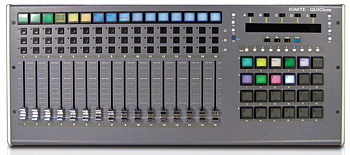The Deciders and The Users

There's a long history in the television industry, and probably other industries that I'm not as familiar with, of the equipment buyers (or deciders) and the equipment users not being on the same page.
Exhibit A of this phenomenon—for anyone who's been around TV that long—was the RCA TK76, one of the first ENG cameras. The camera showed up at our station following an NAB in the '70s, as we were ready to transition from newsfilm to videotape.
The TK76 had several things going for it:
- It was made by RCA, a trusted name in studio cameras and other broadcast equipment;
- It made pretty good pictures;
- We knew our network—NBC—was going to use it, because NBC at that point was owned by RCA.
TK76

Thomson Grass Valley QUICbox controller I wasn't at that NAB. Back then, I was a user, not a decider. But I'm pretty certain the deciders looked at the TK76 on a tripod, viewing the image on a rackmount monitor as they zoomed in on a test chart or well-lit female model. I'm pretty certain none of our deciders put the camera on their shoulder like a user would.
If they had put the TK76 on their shoulder, they would have realized that:
- The camera didn't fit the shoulder because it had a flat bottom, the corner of which dug into your supraspinatus like a knife. (The fix was a shoulder pad added to the bottom, which put the camera itself up too high.)
- The eyepiece was virtually unusable. It was an afterthought, kind of an Erector Set solution that moved away when you put your eye to it. (I don't remember this ever being fixed.)
Like most stations that bought a TK76, we only bought one. It wasn't all that many years later that RCA was out of the broadcast equipment business. Coincidence? I think not.
IGNITE
For all the promises I made to myself in those early years about keeping an open mind, as time goes by I often find myself drawn to making assumptions without talking to users.
This came to mind the other day when I had lunch with a fellow who had been production manager at a sister station in the same group, years ago. We were talking about the manual control panel of the Thomson Grass Valley Ignite integrated production system.
The Ignite provides an integrated video switcher, audio mixer, and teleprompter to allow a single operator to run an entire newscast. While portions of a newscast can be preprogrammed to allow the Ignite to sequence through it, step by step, anyone who's ever worked a newscast knows the unpredictable can and will happen.
To override pre-programmed video and audio elements to accommodate last-minute changes in plans, all but the base model of Ignite includes the QUICbox programmable controller to enable an operator to manually drive the newscast until the time when preprogramming can take over again.
What struck both of us was how unusual the layout of the QUICbox seemed. No switcher effects banks. No CG QWERTY keyboard. Everything is on one panel.
My friend allowed that anyone who had cut his teeth on a Grass Valley 100 or 1,000 series switcher would wonder how in the world you could manually switch a newscast with the QUICbox.
But then we talked about how "gamers," who can go from a PlayStation to an Xbox to a Wii control pad without giving it a moment's thought, would probably have no problem at all figuring out the QUICbox.
This would seem a good place to bring the users into the decision process. And while you can't take the entire station shopping at NAB, there are local equipment shows and traveling road shows put on by dealers where equipment can be seen.
USERS
Another possibility for user input is to have your users contact their counterparts at stations that are already using equipment you're evaluating. They're more likely to get information they can use when talking to people at the same level.
And as important as input from users is, there's also a need for input from the folks who'll have to fix the equipment you're looking at. They've got their own language of words and phrases like single point of failure, test equipment and spare parts.
Even with all this need to get input at the user and fixer level, there is still a role for a manager in the deciding process. You've got to determine if the equipment really fits into the station's workflow and long-range plans, and if it will really deliver the ROI the vendor-supplied spreadsheets say it will.
And you've got to monitor your users as they evaluate the equipment. They may have closed minds as well.
The professional video industry's #1 source for news, trends and product and tech information. Sign up below.
